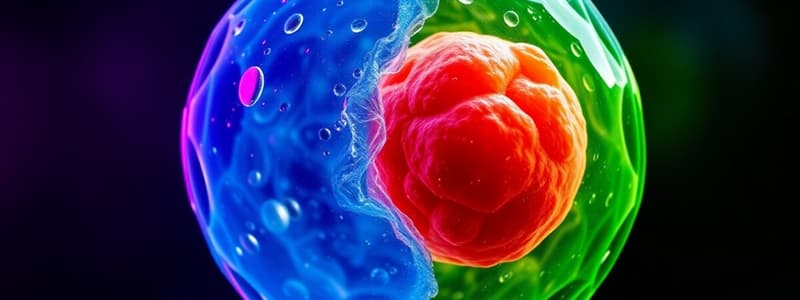Podcast
Questions and Answers
What happens during interphase before mitosis begins?
What happens during interphase before mitosis begins?
- Centrioles move to opposite ends of the cell
- Chromosomes condense into chromatids
- Nuclear membranes begin to form
- Genetic material doubles to create sister chromatids (correct)
Which process occurs during anaphase?
Which process occurs during anaphase?
- Sister chromatids line up at the center of the cell
- Chromatin condenses into visible chromosomes
- Nuclear membranes dissolve
- Sister chromatids separate and move to opposite ends (correct)
What is the role of the centromere during mitosis?
What is the role of the centromere during mitosis?
- To create new nuclear membranes
- To form the spindle fibers
- To condense chromatin into chromosomes
- To hold sister chromatids together (correct)
During which stage of mitosis do the sister chromatids align at the center of the cell?
During which stage of mitosis do the sister chromatids align at the center of the cell?
What occurs during telophase?
What occurs during telophase?
What is true regarding unicellular organisms?
What is true regarding unicellular organisms?
Which of the following describes the concept of homeostasis?
Which of the following describes the concept of homeostasis?
Which statement about cell organization is accurate?
Which statement about cell organization is accurate?
What aspect separates autotrophs from heterotrophs?
What aspect separates autotrophs from heterotrophs?
In what way does growth differ from development in multicellular organisms?
In what way does growth differ from development in multicellular organisms?
Flashcards are hidden until you start studying
Study Notes
Interphase
- The cell prepares to divide
- Genetic material doubles
- Sister chromatids are held together by the centromere
Prophase
- Chromatin condenses
- Chromatin is made up of DNA and proteins that make chromosomes
- Centrioles appear and move to opposite ends of the cell
- Centrioles begin the formation of spindle fibers between the poles
Metaphase
- Sister chromatids line up in the center of the cell
- Sister chromatids are attached to spindle fibers
Anaphase
- Sister chromatids separate and are pulled to opposite ends of the cell by spindle fibers
Telophase
- Two new nuclei and nuclear membranes form
- Chromosomes appear as chromatin
Cytokinesis
- The cell membrane moves inward to create two daughter cells
- Each daughter cell contains its own nucleus with identical chromosomes
Characteristics of Life
- All living things are made of one or more cells, the simplest level of life.
- Not all cells are alike and they perform different functions.
- The cell membrane surrounds and separates the cell from its environment.
- Unicellular organisms are made of a single cell.
- Multicellular organisms are made up of multiple cells.
- All living things are organized.
- In multicellular organisms, cells are organized into tissues, organs, and organ systems.
- Growth results in an increase in living material and the formation of new structures.
- All organisms grow.
- Development involves structural changes that occur during an organism's lifetime.
- Only multicellular organisms go through development.
- Reproduction is the production of offspring.
- Reproduction is vital for the survival of a species, not for an individual organism.
- Without reproduction, a population would go extinct.
- Extinction is when a population of organisms dies out completely.
- All living things respond to stimuli, which can be air, water, weather, temperature, other organisms, etc.
- Organisms respond to stimuli to stay safe and adapt to changes in their environment.
- Organisms respond to the level of water and nutrients within their bodies.
- Energy is the ability to make things change.
- Energy powers life processes and allows organisms to carry out important functions.
- Heterotrophs, like animals, get energy from food.
- Autotrophs, like plants, get energy from the sun through photosynthesis.
- Homeostasis is the regulation of an organism's internal environment to maintain conditions suitable for life.
- Homeostasis keeps everything in balance.
- Sweating is an example of how organisms maintain homeostasis.
- Adaptations evolve over time through natural selection.
Studying That Suits You
Use AI to generate personalized quizzes and flashcards to suit your learning preferences.




